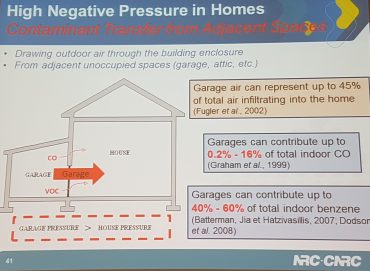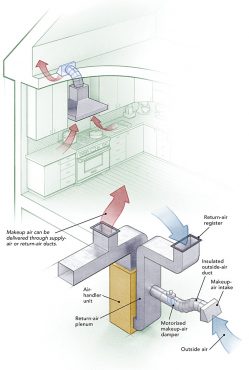
John Bleasby
Change is in Air: The critical importance of IAQ management
Canadian ContractorHRV’s, ERV’s, furnace fans and wood stoves —There’s a lot to consider with today’s tight homes
In Part Three of our series Meeting the Net Zero Energy Challenge, Canadian Contractor continues its examination of Internal Air Quality (IAQ) in a conversation with Wayne Fischer, an industry expert and Ontario Sales manager for Lifebreath, a leading brand of air quality equipment. Understanding the issues surrounding IAQ will be critical for contractors and renovators over the next decade, as Net Zero Energy-ready homes become the building code standard.
We looked at the key differences in performance between Heat Recovery Ventilators (HRV’s) and Energy Recovery Ventilators (ERV’s) in Part Two of this series. What are the cost factors to be considered?
The initial investment is about the same. It’s the core replacement issue that homeowners have to anticipate with an ERV. An HRV core has a lifetime warranty; ERV core warranties will vary from five to 10 years.
Since an ERV deals with both heat and moisture, can it be considered a heat pump of some sort?
Absolutely not. It has a totally different function. A heat pump is for heating; an ERV is ventilation. It’s an air quality device.
What about ‘Double-Core’ HRV’s. Are they twice as efficient?
A double core HRV is simply a more efficient HRV. A single core HRV will perform at 75% efficiency, which meets the latest Ontario codes. A double core system performs at 81%, which exceeds code. It would be a personal decision.

With negative air pressure, the balance has to be achieved somehow. Garages are the likely suspects, which
is dangerous
Can an HRV/ERV share ducting with a forced air system?
It’s said that a totally ducted HRV is the best way to go. I don’t think it makes that much difference. The goal is to get fresh air into the house. Either way will do it. You’ll get a little more performance with a fully ducted system, but at a much higher installment cost. Most builders will put the fresh HRV air supply into the return air of the furnace, because by code you have to deliver fresh air to every habitable room in the house. The furnace does that anyway so you might as well blow the fresh air into the furnace and let it do the job. The HRV exhaust portion comes, for example, from bathrooms or the laundry room, but the fresh air is going into the furnace.
So even if you don’t have forced air heating and cooling, for example radiant heating, you still need an HRV or an ERV right?
No matter how you heat or cool a house, you still have to move the air. IAQ will always be an issue.
Some experts recommend that furnace fans run ‘on demand’ only, not continuously, when used in conjunction with an HRV or ERV
The jury’s out of that one. However, when I look at some of the new furnaces coming out, they’re designed so that you will are not able to turn the fans ‘off’. When you plug that baby in, the fan’s running. The furnace fan’s function is move air within the house and at the same temperature. In a properly designed duct system, you’ll end up with very even temperature throughout the house. It’s taking all of the air and moving it around.

It’s easy to develop negative air pressure in today’s tight houses. A kitchen fan is one way, but there are other exhaust-only appliances that add to the problem. The answer is a make-up air system.
Do HRV’s and ERV’s manage the issue of positive and negative air pressure in a house?
An HRV/ERV cannot calculate the overall air pressure balance within the house itself. That’s a completely different test, calculation and strategy. HRV/ERV air is ventilation air, a balanced system unto its own. For example, in a very tight house that’s closed for long periods, if you have an HRV, a 1000 cfm kitchen range hood, a separate bathroom exhaust, and a wood stove, you will have to do a de-pressurization test on the building envelope. If it is very negative, you’ll have to introduce make-up air. However, if you use the HRV/ERV for the bathroom fan, it maintains the balance.
You said ‘wood stove’. Wood heat and fireplaces are popular home features. Are they a problem in terms of IAQ?It’s an issue in the marketplace. The depressurization factor on new gas equipment is many, many times lower than a woodstove. The guys are doing pressure tests on this all the time, especially with woodstoves. Most HVAC installers will say, ‘Don’t put in a wood fireplace.’”
What other factors impact the selection and design of an HRV/ERV system?
Duct length needs to be addressed at the design stage. You need to know how much air you need to move and then design the duct system to meet that need. The amount of human activity in the building has an impact on the air quality also. That’s generally covered through codes at the home’s design stage, because HVAC designs are based on bedrooms and room counts. The HVAC designer/installer should be asking those questions at the outset in order to recommend the correctly sized system.
Conclusion? Change is the air!
There are many considerations that need serious thought and planning as Canada moves towards a Net Zero Energy-ready future. Strategies to deal with Internal Air Quality should be dealt with as part of the early project planning process, and in conjunction with an HVAC expert.
Catch up on this new series…
Part One: Sealing the Envelope
Part Two: Change is the Air; developing an IAQ strategy
Got feedback? Make your opinion count by using the comment section below,
or by sending an email to:
JBleasby@canadiancontractor.ca
Follow John on Instagram and on Twitter for notifications about his latest posts

![]()

Leave a Reply